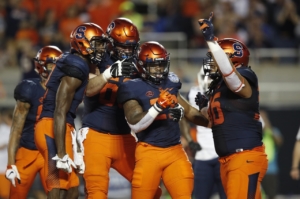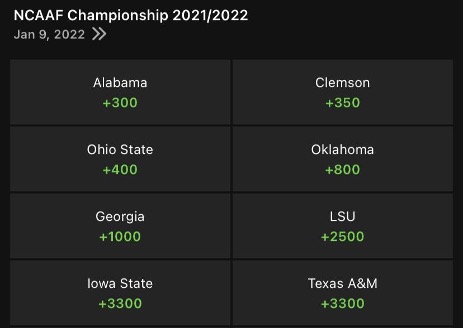College Football Lines & Odds
College Football Lines & Odds

College football is one of the most popular sports to bet on in the US, and that goes for New York as well. Interest is poised to explode even further now that legal online sports betting has come to the Empire State.
While you can’t bet on the in-state teams here in NY, you won’t be lacking for options when it comes to games to bet on. We’ll get you sorted with what you need to know to bet on college football in New York below, including the best college football odds at online sportsbooks plus key things to consider before betting on NCAA football.
College football odds: Moneyline, spread and totals
Below find the latest college football odds as posted at online sportsbooks. Click on any odds to go right to the sportsbook, claim your bonus and make your bets. Use the drop-down menu to change your odds boards. For the full lineup of college football games every week, check our full odds feed for all sports.
How to read college football betting lines
Before bettors can make any money, they need to know how to read NCAA football odds. Let’s look at an example to better understand moneylines, point spreads and totals.
| Spread | Moneyline | Total | |
|---|---|---|---|
| Syracuse | -3.5 (-110) | -180 | Over 52.5 (-105) |
| Rutgers | +3.5 (-110) | +140 | Under 52.5 (-115) |
Above is what a typical set of college football game lines might look like at WynnBet online sportsbook NY. The favorite has a minus sign next to its moneyline and spread, while the underdog’s odds come with a plus sign. In this case, Syracuse is the favorite while Rutgers is the underdog.
Moneyline bets are wagers on which side will win. Most moneylines aren’t going to be equal since teams aren’t of the same caliber, so the section of odds with mismatched numbers is the moneyline. In this example, Syracuse is -180 on the moneyline, and Rutgers is +140 on the moneyline.
The spread is how oddsmakers even out the game from a betting perspective. The figure will be the same for both teams, with the favorite “giving away” points and the underdog “getting” points on the spread. Syracuse is -3.5, which means it needs to win by four or more. Rutgers is +3.5, so a loss by three or fewer (or a win) makes for a winning bet.
The total represents the number of combined points in a game and is easy to identify because it says over or under (or simply has an O and a U) next to it. This figure is the same for both sides, just like the spread.
Most popular bets for college football
Now that we’ve established how to read NCAA football betting lines, we’ll go through how to place each type of bet and how to calculate the risk and potential payout that comes with them.
College football moneylines
It’s worth mentioning again that moneyline bets are wagers on which side will win a given game, regardless of the score. It is the simplest way to wager on a sport.

Determining the risk and payout for moneyline bets is easy once you look at the odds relative to the number 100. Betting favorites means risking whatever the moneyline is for every $100 in profit. For underdogs, the moneyline represents potential winnings if you were to risk $100.
Using our example, betting on Syracuse (-180) means risking $180 for a chance to win $100, risking $90 to win $50, risking $18 to win $10, etc. On the other side, wagering on Rutgers (+140) means laying $10 to win $14, $50 to win $70, $100 to win $140 and so on.
Betting the spread on college football
As mentioned above, not all teams are equal. Point spreads even out the game from a betting standpoint. The point spread is a figure that oddsmakers apply to both teams, and betting on it involves more than just picking which side will win.
As is the case with moneylines, favorites have a minus sign next to the spread and underdogs have a plus sign. Selecting favorites means picking a team to win by a certain amount and wagering on an underdog tells you exactly how much they can lose by and still “cover” the number. At -3.5, Syracuse must win by four or more to cover the spread. At +3.5, Rutgers can win the game or lose by three or fewer to cover the spread.
Think of the spread as a hypothetical number of points you can add or subtract from each team’s score at the end of the game. Once you account for the spread, does that side have more points than the other? If so, it has covered.
To calculate the risk and payout when betting point spreads, you must use the odds number that accompanies the spread in parentheses. If Syracuse is -3.5 (-110), it requires a $110 bet for a chance to win $100, or $11 to win $10, etc. Those looking to bet on Rutgers +3.5 (-110) would need to stake the same amount of money since the line is equal.
The point spread will be the same for both teams. Plenty of times, the price that comes alongside the spread will also be equal for both teams, as is the case with our example. But it’s also possible that the two sides are accompanied by slightly different prices, even if the spreads match up.
Betting the over/under on college football
Totals, or over/unders, are simple to understand and wager on. NY sportsbooks set a number, and bettors wager on whether the combined score of the two teams will be over or under that amount.
With a total set at 52.5 points, a combined score of 53 or higher is a win for bets on the over, while 52 or lower would cash an under. Similar to spreads, the total will be the same on both sides, but it’s possible that the accompanying odds are slightly different.
In our example, the over 52.5 (-105) means risking $105 for $100 in profit. On the other side, taking the under 52.5 (-115) requires a $115 risk to potentially win $100.
Betting Heisman, conference champion and more futures
At the start of the season, there are various markets available related to college football futures betting. The most popular one is the odds to win the national championship, like in this example at the DraftKings Sportsbook app.

Certain markets, including the national championship and the Heisman Trophy winner, are available year-round and even stay up throughout the entirety of the season. Other markets appear just before the season begins, with some updating as the season progresses and others disappearing once the schedule kicks off. The NCAA football futures betting market includes but is not limited to the following:
- National champion
- Conference winner
- Team to make conference title game
- Division winner (conferences with multiple divisions only)
- Regular season win total
- Heisman Trophy winner
- Team to make College Football Playoff
Betting on game and player props
Props, or proposition bets, are wagers that are not conventional moneylines, spreads or totals. In some cases, they can involve the final score of the game, but most of the time, props aren’t directly tied to the outcome.
The prop betting market is not nearly as busy in college football compared to the NFL, where there are tons of options for every game. With that said, you can still find some props on Saturdays, including these here:
- First-half moneyline, spread, total
- Second-half moneyline, spread, total
- Full game team totals
- First/second-half team totals
Once the College Football Playoff arrives, the market expands and sportsbooks tend to include additional options such as player props, kicking props and odds for individual quarters.
How to line shop NCAAF
One tactic that many bettors employ before filling out a bet slip is line shopping. This is the practice of visiting several sportsbooks and looking at how the odds stack up compared to other sites.
Line shopping is one of the main reasons why having multiple sportsbook accounts can be helpful, as it is a way to ensure that you get the best possible college football odds for a wager you want to place.
Leading up to the time a game starts, betting lines may move from the oddsmakers’ original figure. The goal when sportsbooks set the line, in theory, is to create an equal amount of interest from the public on both sides. When members of the public start placing their bets and wagering is imbalanced toward one side or another, sportsbooks tend to alter their lines to compensate.
For spreads and totals, many lines begin at -110 on both sides. Sportsbooks could set odds with uneven prices but even in those cases, the price doesn’t vary too far from -110 at the start.
From there, line moves begin after the public begins to act. The most common cause of movement is a lopsided amount of money or wagers. These two things can be occurring on the same side of a game, but it’s possible for the majority of bets to be on one side and the majority of money to be on the other.
Line moves can be an indication of which side the public favors, but they can also move against the team that is popular with the public. This is called reverse line movement, and it’s an indication that well-respected or professional bettors (also known as sharps) are taking the other side.
Make a habit of checking your online sportsbook app at several points throughout the day and noticing the line changes. If action continues to hit one side and the NCAAF odds reach a certain point, the sportsbook may adjust the line by a half point.
NFL vs. NCAA football betting
College football betting isn’t all that different from wagering on other sports, and the best league to draw comparison from is the National Football League.
They are very similar in nearly all respects since it is the same sport, after all. It’s a 60-minute game made up of four quarters, and there are still 11 players on the field for each team at any given time. You still need 10 yards for a first down, field goals are worth three and touchdowns are worth six before the extra point.
While the majority of the rules are the same as well, there are some aspects of the college game that make betting on it very different from betting on the NFL. For starters, there are 130 NCAA Division I-A (FBS) programs in the country compared to just 32 NFL teams. This plays a role from a betting perspective in multiple ways:
- Larger spreads: It’s not the case for all college games, but many games will feature much larger spreads than we see in the NFL. Most professional spreads are single digits but the college game has much less parity with so many schools, creating plenty of mismatches on the schedule.
- Higher totals: Many college games feature more scoring than your average NFL game, and sportsbooks account for that by setting high totals. The clock stops after first downs in college, which is one of the main differences between the two in terms of gameplay. This helps create more possessions for each team throughout a game and leads to higher scores.
- More valuable betting lines: There’s anywhere from a dozen to 16 NFL games in a week, and oddsmakers and the public pour over each one carefully. With up to 75 Division I-A college games per week, plenty of games don’t get nearly as close of a look. This can lead to value, especially once you get beyond the largest schools and conferences
- Less betting action: Even though the NCAA game is popular to bet on, it doesn’t reach the level of the NFL. Add that to the fact that there are so many games to choose from, and there’s less betting action on even the most highly anticipated college matchups compared to what we see on Sundays.
Keep in mind that college football players aren’t professionals. Players in the college game can end up making more mistakes when it comes to fundamentals. You generally see more missed kicks, missed throws and sloppy play when you’re watching amateur athletes.
It’s also important to know that coaching and experience matter. Teams with more experience tend to make fewer errors and can be more reliable to wager on. The same goes with strong coaching. Leading a college program is like being the CEO of a company and involves more oversight than coaching a group of professional experts at their craft.
Online betting vs. retail sportsbooks
You can generally place sports bets either in person at a retail sportsbook or by using an online betting site. While retail sportsbooks have been around for decades, there’s really no debating that the emergence of online betting in recent years has made placing your wagers far easier and more convenient.
Betting online comes with several advantages that you don’t receive at a land-based venue, including the following:
- Wagering from a location of your choice (inside a legal betting state)
- Welcome bonuses
- Ongoing site promotions
- Variety of banking methods
- Live betting on an app
- Parlay odds calculated instantly
How to bet on college football in NY
If you’re interested in betting on college football but don’t know where to start, we can help with that. The first step is getting signed up for a new online sportsbook account, which is a simple process and one you can complete in a matter of minutes.
- Choose your preferred sportsbook and click one of our links to be redirected to the sign-up page.
- Complete your registration by filling out all required fields (name, email, home address, upload ID, etc.).
- Choose your banking method and deposit into your new account.
- Your account balance should reflect your deposit and your welcome bonus (if there is one).
- Download the online sportsbook app for the site you just signed up for.
- Sign in and place your bets.
Once your registration is complete, you will receive an email confirming your new account. The sportsbook also sends confirmation emails following every deposit and withdrawal to verify the transaction. When it’s time to place bets, your location will be verified with geolocation tracking. If you’re not within state lines, bets won’t go through.
New York college football teams
While betting on college football is commonplace for New Yorkers, the state itself doesn’t house many teams that play in Division I-A, also known as the Football Bowl Subdivision. The relatively short list includes:
- University at Buffalo
- Syracuse University
- United States Military Academy (Army)
All three programs extend back to the late 1800s and are rich in history, having been playing football for well over a century. Between them they have claimed four national titles, with Army winning three in a row in 1944, 1945 and 1946, and Syracuse winning in 1959.
Army’s previous history as a powerhouse led to two dozen players from the academy being inducted into the College Football Hall of Fame and several being drafted into the NFL.
Several well-known NFL players have attended Syracuse, including Hall of Famers Jim Brown, John Mackey and Marvin Harrison, along with six-time Pro Bowl quarterback Donovan McNabb and two-time Super Bowl champion running back Larry Csonka.
The most notable player to attend Buffalo is linebacker Khalil Mack, who was drafted with a top-five pick in 2014 by the Oakland Raiders.
When it comes to wagering on any of these schools, note that you are not allowed to bet on schools that are in New York from inside the state. This restriction is similar to one that is in place in New Jersey and several other states, and extends to betting on college bowl games.
Is college football betting legal?
Yes, college football betting is legal with NY sports betting apps. The only restriction, as mentioned above, is that some states don’t allow betting on schools that are located inside the state, including New York and neighboring New Jersey.
